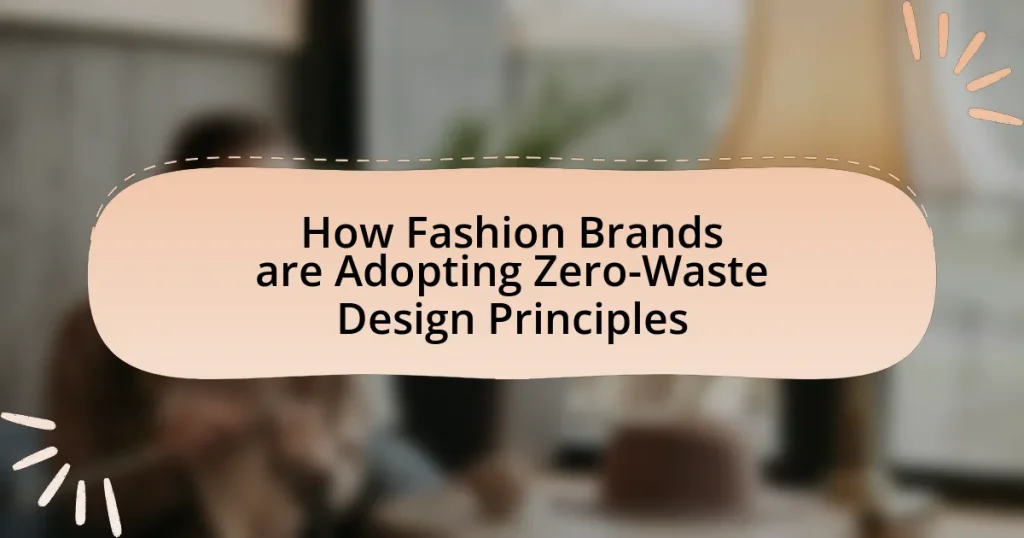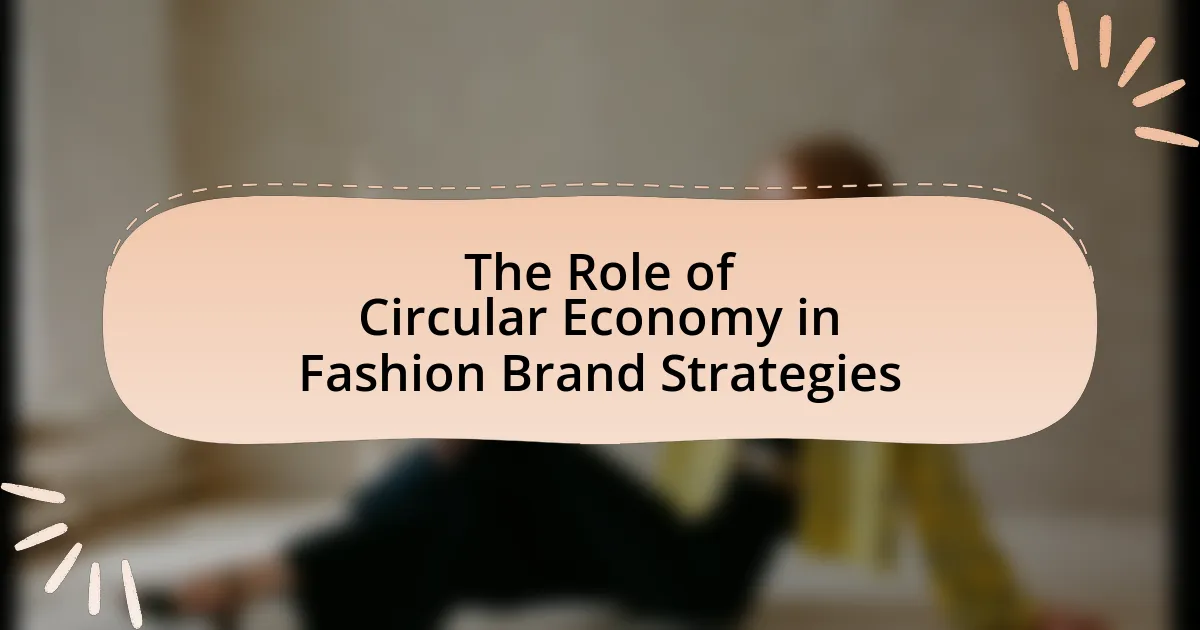The article focuses on how fashion brands are adopting zero-waste design principles to eliminate textile waste during the design and production processes. It outlines the differences between zero-waste and traditional fashion design, emphasizing the innovative techniques used to maximize fabric utilization and minimize off-cuts. Key characteristics of zero-waste design, its importance for sustainability, and the challenges brands face in implementation are discussed. Additionally, the article highlights successful brands leading the way in zero-waste practices, the role of technology, and future trends in the industry, providing a comprehensive overview of the impact of zero-waste design on fashion and consumer behavior.

What are Zero-Waste Design Principles in Fashion?
Zero-Waste Design Principles in fashion aim to eliminate textile waste during the design and production processes. These principles focus on creating patterns that utilize the entire fabric, thereby minimizing off-cuts and scraps. For instance, designers like Holly McQuillan and Zero Waste Daniel employ techniques such as pattern-making that maximizes fabric use, resulting in garments that leave little to no waste. This approach not only reduces environmental impact but also promotes sustainability in the fashion industry, aligning with the growing demand for eco-friendly practices.
How do zero-waste design principles differ from traditional fashion design?
Zero-waste design principles focus on eliminating textile waste during the production process, while traditional fashion design often prioritizes aesthetics and market trends, potentially leading to excess material waste. In zero-waste design, every piece of fabric is utilized, often through innovative pattern-making techniques that maximize fabric use, whereas traditional methods may result in leftover scraps. This approach not only reduces environmental impact but also promotes sustainability in the fashion industry, as evidenced by brands like Zero Waste Daniel, which have successfully implemented these principles to create garments without generating waste.
What are the key characteristics of zero-waste design?
Zero-waste design is characterized by the intention to eliminate waste throughout the design and production process. This approach emphasizes the use of every material in a way that minimizes offcuts and surplus, often through innovative pattern-making techniques that maximize fabric utilization. Additionally, zero-waste design promotes the use of sustainable materials and encourages the creation of products that can be easily disassembled or recycled at the end of their life cycle. The effectiveness of this design philosophy is supported by examples from fashion brands that have successfully implemented these principles, demonstrating reduced environmental impact and resource efficiency.
Why is zero-waste design important for sustainability?
Zero-waste design is important for sustainability because it minimizes resource consumption and waste generation in the production process. By employing techniques that ensure every material is utilized, zero-waste design reduces the environmental impact associated with textile waste, which accounts for approximately 92 million tons annually, according to the Ellen MacArthur Foundation. This approach not only conserves natural resources but also promotes a circular economy, where materials are reused and recycled, further enhancing sustainability in the fashion industry.
What challenges do fashion brands face when adopting zero-waste design principles?
Fashion brands face significant challenges when adopting zero-waste design principles, primarily due to the need for a complete overhaul of traditional design processes. This transition often requires extensive training and a shift in mindset among designers, who must learn to create patterns that utilize every scrap of fabric, which can be time-consuming and complex. Additionally, sourcing materials that align with zero-waste goals can be difficult, as many sustainable fabrics are not widely available or are more expensive than conventional options.
Moreover, the existing manufacturing infrastructure is typically not designed to accommodate zero-waste practices, leading to logistical hurdles in production. Brands may also encounter resistance from consumers who are accustomed to conventional fashion cycles, making it challenging to market zero-waste products effectively. According to a study published in the Journal of Fashion Marketing and Management, only 30% of consumers are willing to pay more for sustainable fashion, highlighting the economic barriers brands face in this transition.
How do production processes impact the implementation of zero-waste design?
Production processes significantly influence the implementation of zero-waste design by determining material efficiency and waste generation. Efficient production methods, such as pattern making and cutting techniques, can minimize fabric waste, which is crucial for zero-waste design principles. For instance, brands that adopt digital pattern-making technologies can optimize fabric usage, reducing offcuts and scraps. Additionally, the choice of materials impacts waste; sustainable materials that can be recycled or composted align better with zero-waste goals. Research indicates that brands implementing lean manufacturing practices have successfully reduced waste by up to 30%, demonstrating a direct correlation between production processes and zero-waste outcomes.
What are the common misconceptions about zero-waste fashion?
Common misconceptions about zero-waste fashion include the belief that it is only about recycling materials and that it is unaffordable. Zero-waste fashion encompasses a holistic approach to design, focusing on minimizing waste during the production process, which includes using patterns that eliminate fabric scraps and sourcing sustainable materials. Additionally, while some zero-waste items may have a higher upfront cost, many brands are increasingly offering affordable options as consumer demand grows, making sustainable choices more accessible.

How are Fashion Brands Implementing Zero-Waste Design Principles?
Fashion brands are implementing zero-waste design principles by creating patterns that utilize the entire fabric without generating offcuts. For instance, brands like Zero Waste Daniel and Reformation design garments that maximize fabric use through innovative cutting techniques and modular designs. These approaches not only reduce waste but also promote sustainability in the fashion industry, as evidenced by a study from the Ellen MacArthur Foundation, which highlights that the fashion sector could reduce its environmental impact significantly by adopting such practices.
What strategies are fashion brands using to adopt zero-waste design?
Fashion brands are adopting zero-waste design strategies by implementing techniques such as pattern making that maximizes fabric use, utilizing digital technologies for precise cutting, and creating modular clothing that can be easily reconfigured. For instance, brands like Zero Waste Daniel employ innovative pattern-making methods that ensure every scrap of fabric is used, significantly reducing waste. Additionally, companies like Reformation leverage 3D design software to optimize material usage, which minimizes offcuts during production. These strategies not only enhance sustainability but also align with consumer demand for environmentally responsible fashion.
How do brands incorporate innovative materials in zero-waste design?
Brands incorporate innovative materials in zero-waste design by utilizing biodegradable fabrics, recycled textiles, and upcycled materials to minimize waste. For instance, companies like Stella McCartney use organic cotton and recycled polyester, which reduce the environmental impact of production. Additionally, brands such as Eileen Fisher implement take-back programs that allow customers to return used garments, which are then transformed into new products, effectively closing the loop in the production cycle. This approach not only reduces landfill waste but also promotes a circular economy within the fashion industry.
What role does technology play in facilitating zero-waste practices?
Technology plays a crucial role in facilitating zero-waste practices by enabling efficient resource management and innovative design solutions. Advanced software tools, such as computer-aided design (CAD) and 3D modeling, allow fashion brands to optimize patterns and minimize fabric waste during production. For instance, companies like Unspun utilize digital weaving technology to create garments on demand, significantly reducing excess inventory and material waste. Additionally, data analytics helps brands track and analyze waste generation, leading to informed decisions that enhance sustainability efforts. These technological advancements not only streamline production processes but also promote a circular economy by encouraging recycling and upcycling initiatives within the fashion industry.
Which fashion brands are leading the way in zero-waste design?
Fashion brands leading the way in zero-waste design include Eileen Fisher, Reformation, and Zero Waste Daniel. Eileen Fisher has implemented a program called “Renew,” which focuses on recycling and repurposing garments, significantly reducing textile waste. Reformation utilizes sustainable materials and practices, aiming for a circular economy by designing clothes that can be recycled at the end of their life cycle. Zero Waste Daniel specializes in creating garments from fabric scraps, ensuring that no material goes to waste. These brands exemplify innovative approaches to sustainable fashion, contributing to the reduction of environmental impact in the industry.
What specific collections or lines exemplify zero-waste design principles?
Specific collections that exemplify zero-waste design principles include the “Zero Waste” collection by designer Holly McQuillan and the “No Waste” line by the brand Reformation. Holly McQuillan’s collection utilizes innovative pattern-making techniques that minimize fabric waste, while Reformation’s No Waste line focuses on using leftover materials from previous collections, effectively reducing textile waste. Both collections demonstrate a commitment to sustainability by prioritizing resource efficiency and responsible production methods.
How do these brands measure the success of their zero-waste initiatives?
Brands measure the success of their zero-waste initiatives primarily through metrics such as waste diversion rates, reduction in material usage, and customer engagement levels. For instance, companies often track the percentage of waste diverted from landfills, aiming for a target of 90% or higher, which indicates effective waste management practices. Additionally, brands analyze the reduction in raw material consumption, often quantified in terms of percentage decrease compared to previous production cycles. Customer engagement is assessed through feedback and participation in recycling programs, which can be measured by the number of customers returning products for recycling or the uptake of sustainable product lines. These metrics provide concrete evidence of the effectiveness of zero-waste strategies and help brands refine their approaches.

What Impact Does Zero-Waste Design Have on the Fashion Industry?
Zero-waste design significantly reduces textile waste in the fashion industry by promoting the use of every inch of fabric in garment production. This approach not only minimizes environmental impact but also encourages innovative design techniques, as brands must creatively utilize materials to avoid waste. For instance, a study by the Ellen MacArthur Foundation highlights that the fashion industry generates over 92 million tons of waste annually, indicating a pressing need for sustainable practices like zero-waste design. By adopting these principles, brands can enhance their sustainability credentials, attract eco-conscious consumers, and contribute to a circular economy, ultimately reshaping industry standards and practices.
How does zero-waste design influence consumer behavior?
Zero-waste design significantly influences consumer behavior by promoting sustainability and encouraging conscious purchasing decisions. This design approach minimizes waste throughout the production process, appealing to environmentally aware consumers who prioritize eco-friendly practices. Research indicates that 66% of global consumers are willing to pay more for sustainable brands, demonstrating a shift towards valuing products that align with zero-waste principles. Additionally, brands that adopt zero-waste design often engage in transparent communication about their practices, fostering trust and loyalty among consumers who seek to support responsible businesses.
What are the environmental benefits of adopting zero-waste design?
Adopting zero-waste design significantly reduces environmental impact by minimizing waste generation and promoting resource efficiency. This approach leads to decreased landfill contributions, as products are designed to utilize materials fully, thereby diverting waste from disposal sites. For instance, a study by the Ellen MacArthur Foundation highlights that implementing circular design principles can reduce textile waste by up to 80%. Additionally, zero-waste design encourages the use of sustainable materials and processes, which lowers carbon emissions associated with production. By fostering a closed-loop system, zero-waste design not only conserves resources but also enhances biodiversity by reducing pollution and habitat destruction linked to traditional manufacturing practices.
How does zero-waste design affect brand reputation and loyalty?
Zero-waste design positively affects brand reputation and loyalty by aligning with consumer values around sustainability. Brands that implement zero-waste practices demonstrate a commitment to environmental responsibility, which enhances their image and attracts eco-conscious consumers. Research indicates that 66% of global consumers are willing to pay more for sustainable brands, showcasing a direct correlation between sustainable practices and customer loyalty. Furthermore, brands like Patagonia and Eileen Fisher have successfully built strong reputations and loyal customer bases by prioritizing zero-waste initiatives, reinforcing the idea that sustainable design can lead to increased brand trust and consumer retention.
What are the future trends in zero-waste fashion design?
Future trends in zero-waste fashion design include the increased use of digital pattern-making technologies, which optimize fabric usage and minimize waste. Brands are adopting 3D knitting and weaving techniques that allow for seamless garment construction, further reducing leftover materials. Additionally, there is a growing emphasis on upcycling and the use of biodegradable materials, as consumers demand more sustainable practices. Research indicates that the global sustainable fashion market is projected to reach $8.25 billion by 2023, highlighting the shift towards eco-friendly design principles.
How might regulations shape the adoption of zero-waste practices in fashion?
Regulations can significantly shape the adoption of zero-waste practices in fashion by mandating sustainable production methods and waste reduction targets. For instance, the European Union’s Circular Economy Action Plan encourages member states to implement policies that promote recycling and waste management, directly influencing fashion brands to adopt zero-waste strategies. Additionally, regulations such as the Extended Producer Responsibility (EPR) laws require manufacturers to take responsibility for the entire lifecycle of their products, incentivizing them to design for minimal waste. These regulatory frameworks create a structured environment that compels fashion brands to innovate and integrate zero-waste practices into their operations, ultimately leading to a more sustainable industry.
What innovations are on the horizon for zero-waste design in the industry?
Innovations on the horizon for zero-waste design in the fashion industry include advanced digital pattern-making technologies, which optimize fabric usage and minimize waste. These technologies utilize algorithms to create patterns that fit together seamlessly, reducing leftover material. Additionally, the integration of 3D knitting and weaving techniques allows for the production of garments with minimal or no seams, further decreasing waste. Research from the Ellen MacArthur Foundation indicates that adopting such technologies can significantly reduce fabric waste by up to 30%. Furthermore, the rise of biodegradable and recyclable materials is set to enhance zero-waste practices, enabling brands to create products that can be fully reclaimed at the end of their lifecycle.
What practical steps can emerging fashion brands take to adopt zero-waste design principles?
Emerging fashion brands can adopt zero-waste design principles by implementing pattern-making techniques that maximize fabric usage, such as using digital tools to create efficient layouts. These brands can also focus on designing garments that can be easily disassembled for recycling, thereby reducing waste at the end of a product’s life cycle. Additionally, they can source materials that are biodegradable or made from recycled content, which supports a circular economy. Research indicates that brands employing these strategies can significantly reduce textile waste, as evidenced by a study from the Ellen MacArthur Foundation, which highlights that the fashion industry could reduce its environmental impact by adopting circular practices.
How can brands start small while aiming for zero-waste goals?
Brands can start small while aiming for zero-waste goals by implementing incremental changes in their production processes, such as using sustainable materials and optimizing patterns to minimize fabric waste. For instance, brands can begin by sourcing organic or recycled fabrics, which reduces environmental impact and aligns with zero-waste principles. Additionally, adopting digital pattern-making technologies can help brands create more efficient designs that utilize fabric more effectively, thereby reducing waste. According to a study by the Ellen MacArthur Foundation, transitioning to circular fashion practices can significantly decrease waste, demonstrating that even small adjustments can contribute to broader sustainability goals.
What resources are available for brands looking to implement zero-waste design?
Brands looking to implement zero-waste design can access various resources, including guidelines from organizations like the Ellen MacArthur Foundation, which provides comprehensive frameworks for circular economy practices. Additionally, the Zero Waste Design Principles by the Fashion Institute of Technology offer specific strategies for minimizing waste in fashion design. Research papers, such as “The Role of Design in Zero Waste Fashion” by S. Fletcher and S. Tham, published in the Journal of Fashion Technology & Textile Engineering, provide empirical evidence and case studies on successful zero-waste implementations. Furthermore, online platforms like the Sustainable Fashion Forum and workshops hosted by industry experts can offer practical insights and networking opportunities for brands committed to zero-waste initiatives.




